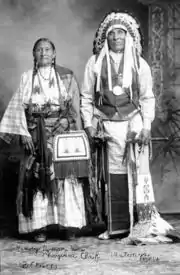Henry Roman Nose
Chief Henry Roman Nose (June 30, 1856 – June 12, 1917) was a highly respected Southern Cheyenne Chief.[1] Living during turbulent times, Roman Nose was recognized for facilitating a peaceful transition to a non-nomadic way of life, while retaining elements of his Cheyenne culture.[2] He was a vocal proponent of obtaining education and training.[3]


As a young warrior, Henry Roman Nose participated in the Red River War. After being captured, he was sent in 1878 to Fort Marion in St. Augustine, Florida, where he was listed as a "ringleader".[4] After release, he attended the Hampton Institute in Virginia and the Carlisle Institute in Pennsylvania.[5] In 1892, he received a land allotment in current-day Blaine County, Oklahoma. This land later became part of the Roman Nose State Park, which was named in his honor.[6]
Henry Roman Nose died in 1917 in the canyon on which Roman Nose State Park was established.[7]
He is depicted in a mural, "Roman Nose Canyon", at United States Post Office Watonga, painted by Edith Mahier in 1941.[8]
Reference list
- "Henry Roman Nose". American-Tribes.com. Retrieved 2013-02-21.
- "Chief Roman Nose". Leisure and Sports Review. Retrieved 2013-02-21.
- Hazel W. Hertzberg (1971). The Search for an American Indian Identity: Modern Pan-Indian Movements. Syracuse University Press. p. 116. ISBN 9780815622451.
- Gil Wilson. "Names of Plain Indians Held at Fort Marion". Dr. Bronson and Friends: A History of the City of St. Augustine. Retrieved 2013-02-21.
- Hampton Normal and Agricultural Institute (1893). Twenty-two Years' Work of the Hampton Normal and Agricultural Institute at Hampton, Virginia. Normal School Press. p. 327.
Henry Roman Nose.
- Alan Boye (2001). Holding Stone Hands: On the Trail of the Cheyenne Exodus. University of Nebraska Press. p. 336. ISBN 0803261853.
- Jernigan, Meg "Roman Nose State Park Near Watonga, Oklahoma." Retrieved March 20, 2014.
- Alyson Greiner (July 19, 2007). "National Register of Historic Places Inventory/Nomination: United States Post Office Watonga". National Park Service. Retrieved April 27, 2017. With 14 photos, including multiple views of the mural.
External links
- "Chief Henry Caruthers Roman Nose". Find A Grave. Retrieved 2013-02-21.
